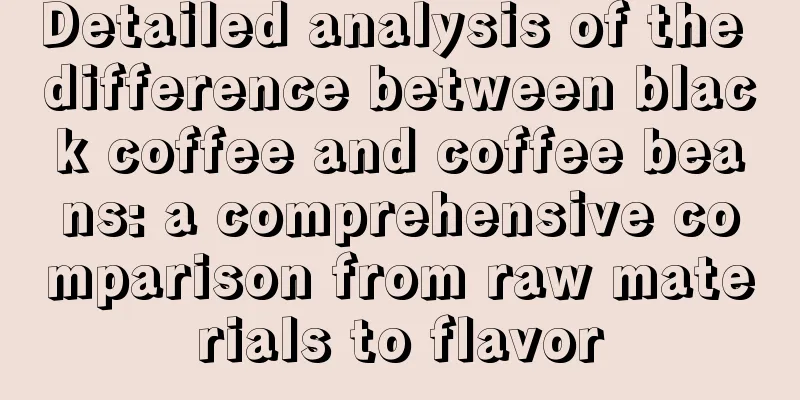Master the three stages of hand brewing coffee! Let you brew good coffee

|
Hand-brewed coffee can control the characteristics of the extraction results. This is the advantage of hand-brewed coffee, but also its most troublesome part, because there are so many variables to consider, including grinding coarseness, powder-water ratio, water temperature, etc. But as long as you understand the relationship between the variables, you can control the flavor of the brewed coffee. The key to mastering extraction and brewing better coffee is to understand the three stages of hand-poured coffee. The author interviewed Patrik Stridsberg, founder of London 3TEMP, and coffee expert Will Corby to help everyone understand the three stages of hand-poured coffee. 1. Pre-soak (steaming) The first stage of hand-brewed coffee is called pre-infusion or steaming, which involves injecting a small amount of hot water to moisten the coffee powder, and then waiting for about 30 seconds. The purpose of this is to remove carbon dioxide. The gas produced when the coffee beans are roasted will be trapped inside the coffee beans. After roasting, the coffee will slowly exhaust gas. When the coffee is brewed, the gas will also be released. When the coffee powder comes into contact with hot water, the remaining gas will be released. This process is called steaming. The more gas is discharged, the greater the expansion of the steaming. Steaming helps the development of coffee flavor for two main reasons: first, carbon dioxide itself has a pungent sour taste, and this taste will not be pleasant when incorporated into coffee (the sour taste mentioned here is different from fruit acid and lively acidity). Secondly, when the coffee powder releases gas, the gas will interfere with the contact between the coffee powder and the water, causing the extraction process to be affected by the gas, and you want this process to happen in the pre-infusion stage, not in the later stage of the extraction process. Pre-infusion can reduce the inconsistency of the extracted flavor. 2. Extraction The next stage of hand-brewed coffee is to start controlling the flavor of the brewed coffee. Different chemicals will be extracted at each stage of brewing. First, the fruit acidity in the coffee will be extracted, followed by sweetness, and finally bitterness (but it is worth noting that not all acids are as pleasant as fruit acidity. For example, chlorogenic acid will produce astringency, dryness and bitterness. In this article, we only look at acids that produce positive acidity). Since different chemical substances will be extracted from coffee at different times of hand brewing, you can create your favorite coffee flavor by adjusting the brewing method. The best way is to control the water temperature and brewing time. Generally speaking, the ideal hand-brew temperature is about 90-96 degrees. Depending on the degree of roasting, flavor characteristics, solubility, freshness of the beans themselves, and grinding coarseness, all of these have corresponding most suitable water temperatures. Patrik said that it is very important to cut off the water supply at this stage, that is, the brewer injects the water in multiple times. When hand-brewing coffee, some people suggest reducing the number of water cuts to improve the stability of each brewing, which eliminates the human error caused by the barista. However, Patrik said that water cut-off is very important because he believes that water cut-off can lead to more stable and efficient extraction. Because a larger water flow and fewer water injections will shorten the extraction time, while multiple water injections with a small water flow can make the coffee grounds bed flatter. The number of water cut-offs varies depending on the nature of the coffee and the coarseness of the grind. 3. Finishing The end of hand-poured coffee is defined here as the last 40% of the water. Patrik said that this part should be controlled very carefully, because the last stage of extraction will easily release the bitterness and other unpleasant flavors in the coffee. Even if the previous stage is done well, the final over-extraction will ruin the cup of coffee. Patrik recommends carefully adjusting the brewing time and water temperature. The final stage may result in less extraction due to the drop in water temperature. Similarly, if you can master the brewing water temperature at this stage, you can create a cup of coffee with good balance, sweetness and acidity. If you are pouring coffee by hand, the water temperature will naturally drop, but if you are using a coffee machine or a hand pouring machine, you may be able to set the water temperature in stages. Patrik said that the Hipster hand pouring machine can be set to, for example, 97 degrees for pre-infusion, 94 degrees for extraction, and 89 degrees for finishing. The finishing temperature of the example data is even five degrees lower than the water temperature used for extraction. Although Patrik recommends different brewing parameters for different coffees, he says water temperature is still key to influencing the sweetness, fruitiness and balance of the coffee. Whether you are brewing single servings of coffee at home or brewing a large batch at once, it is important to understand the three stages of brewing, and controlling the water temperature is one of the most important variables to pay attention to. Understanding how these three stages relate to each other can help us create the coffee we enjoy. Translated from Perfect Daily Grind Translated by Cheng Zhen Coffee Disclaimer: Some of the pictures in this article are from the Internet. For some of the content on the website, such as pictures, we will respect the copyright of the original work and indicate the source, but due to the large number of pictures, some pictures and texts may not be indicated in time, please forgive me. If the original author has any disputes, please contact the website to deal with it. Once verified, we will correct it immediately. It is edited by "Coffee Workshop". Please indicate the source when reprinting. This article is intended to spread coffee culture. If there is any infringement, please inform us to delete it. Thank you~! |
<<: A Beginner's Guide to Pour-Over Coffee | Pure Tips
Recommend
The best choice for boys! A great choice among Starbucks coffees
The best choice for boys! A great choice among St...
Coffee bean pricing: How to seize business opportunities in a volatile market?
As a global commodity, the price of coffee beans ...
Top 10 coffee bean brands: Do you know which brand is the most popular?
Coffee is one of the most popular drinks in the w...
The top ten coffee shop brands in China
The top ten coffee shop brands in China The devel...
Three-in-one coffee, a journey of taste, exploring the source of delicious coffee
Three-in-one coffee is a popular drink with a uni...
The secret of making Matcha Latte, the exclusive recipe revealed
The secret to making Matcha Latte is to use high-...
The impact of instant coffee on the body: health risks cannot be ignored
introduction Instant coffee is a convenient and f...
Choose the most suitable coffee beans to take your coffee taste to the next level
Choose the most suitable coffee beans to take you...
Coffee drinking alone
The moment of savoring coffee alone is a unique e...
From coffee beans to aroma, a perfect production guide!
Coffee is one of the world's most popular bev...
Coffee latte art, the perfect combination of art and technology
Coffee latte art is a perfect combination of art ...
Is a home coffee machine really worth buying?
Whether a home coffee machine is worth buying dep...
The freshness of coffee beans is actually a mystery
Many customers who bought coffee beans complained ...
Do coffee beans grow on trees?
Learn the truth about coffee beans Coffee beans a...
Top 10 Coffee Shops in China: Popular Cafes You Can’t Miss!
Top 10 Coffee Shops in China: Popular Cafes You C...









